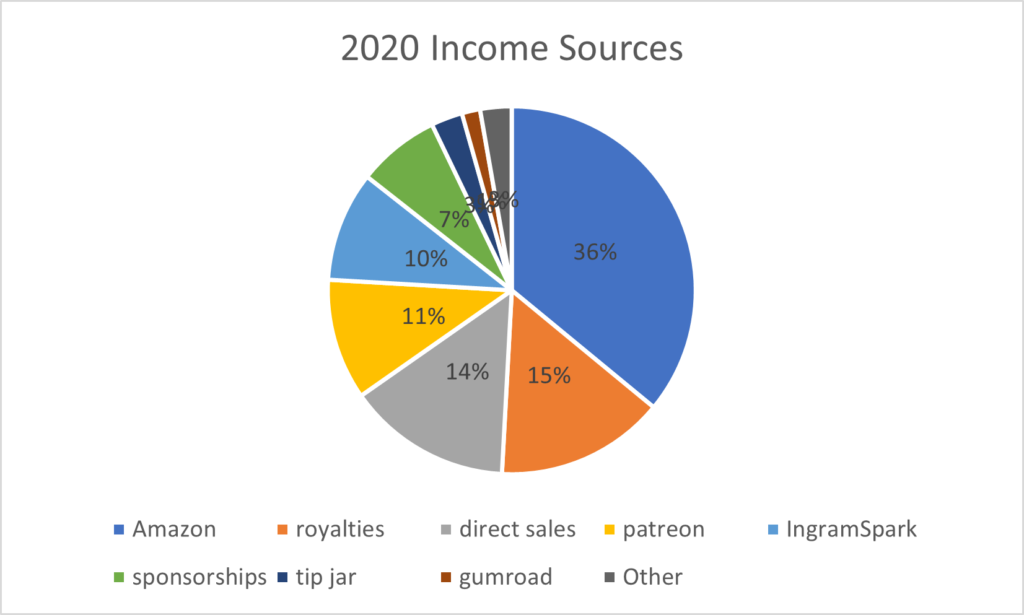My post on where my income came from in 2019 stirred interest, so I’m sharing the same information this year.
I had this bright idea that I could perhaps extract and share other useful information from my business data. I dug and found many strange things–but, while they’re interesting, they’re not actionable. It was all minutae like “Cash Flow for Creators sold five times as many copies on my own e-bookstore as it sold in all other channels combined.”
That’s not just interesting, it’s downright weird. It’s also utterly non-actionable, unless you’re trying to say “A book that doesn’t sell on one platform might sell on another.”
So, forget extra information. Here’s where my money comes from.

Or, if you like percentages, here’s everything including “other” detail. Not quite 100% due to rounding.
- 36% – Amazon KDP
- 15.9% – Royalties
- 14.5% – Direct sales (tiltedwindmillpress.com)
- 10.6% – Patreon
- 9.7% – IngramSpark
- 7.3% – Sponsorships
- 2.8% – Tip jar
- 1.6% – Gumroad
- 1% – Apple
- 0.6% – Kobo
- 0.5% – Aerio
- 0.2% – Draft2Digital
- 0.05% – Barnes & Noble
- 0.03% – Audiobook
Minor income sources, like my affiliate income, don’t appear here. Amazon’s affiliate program was once a nice way to get a few hundred bucks a year, but they’ve cut the rates so much I no longer find it worthwhile.
Amazon is still my single biggest distributor, but they aren’t a majority. I don’t prioritize them or advertise to them. They’re in the business of selling books, I let them sell my books.
The royalties are my traditional publishing income. A chunk of this is certainly sold through Amazon. As trad publishers push to diversify distributors at least as much as I do, I’m going to assume that their diversification efforts are at least as effective as mine, and that about a third of this is sold through Amazon. This means Amazon is about 41% of my income, pretty much the same as last year.
Direct sales are slightly up from last year, which is nice. I do steer people to direct sales as much as possible.
IngramSpark handles non-Amazon paperback sales and all hardcover sales. I introduced hardcover books with the second edition of SSH Mastery, and people started snapping them up. Who am I to argue with readers? My best-selling hardcover is, to my surprise, the Networknomicon. Go figure.
I’m going to lump a few things together: Patreon, sponsorships, and the tip jar. Money from “people who want my books to exist” makes up about a fifth of my income. My Patreon was new in 2019, and didn’t run through the entire year, so “up from last year” isn’t a meaningful statement. I’d like to add the folks who buy direct and throw in a tip on top of the purchase price. Sadly, WooCommerce’s Name Your Price plugin doesn’t report on how many folks pay extra for books, but I see a whole bunch of you paying $6 for a $5 book, or even $12 or $15 for a $10 book.
In this year of plague and political upheaval, as our economy grows increasingly K-shaped, I am especially grateful to you folks who back me out of the goodness of your hearts.
Or maybe you just like watching the Lucas Train Wreck. Whichever, I appreciate it.
I didn’t believe my Patreon would work. It did. That’s why I increased my Patronizer benefits this year, and launched direct sales of Patronizer benefits through my bookstore. If I’m going to sell something, I’m going to sell it directly. Disintermediation is the future for creatives.
Gumroad? If I didn’t have my own bookstore, Gumroad would be business-critical. As things stand, though, it’s mostly for folks who want to buy books in PDF but must also pay EU VAT. (I don’t sell enough goods in the EU to make filling out the paperwork worthwhile. Yet.)
Apple, Kobo, and draft2digital? I’m glad that 2% of my users can get their books through the channels most convenient to them. I truly want to support you folks.
Kobo in particular has an interesting sales pattern. Folks don’t buy one of my books on Kobo. They buy a book, and then a day or two later start buying all the rest of my books. Voracious readers are a writer’s best fans. Sadly, sales on Kobo are low enough that I can see this pattern–but those are exactly the readers I want.
My Aerio store lets me sell books directly to you without touching the books. I like that. They’re new as of the middle of this year, so I expect them to be higher next year.
Barnes & Noble? I’ve spent months of my life wandering through your stores. Today, you’re killing me.
Last, audiobook income. Note the singular. I released my best-selling short story in audiobook for April Fools’ Day. It’s the perfect length to listen to on your commute. I am convinced that’s why everyone stopped commuting in March. The good news is, the payback time on this audiobook is a paltry seven years.
In summary:
If I lost any one channel, I would survive.
Disintermediation is the way. Sell direct to customers.
Make your books as widely available as possible.
